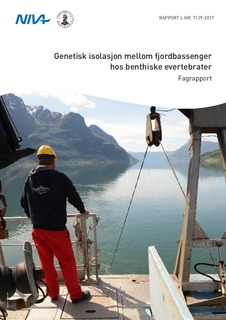| dc.contributor.author | Hobæk, Anders | |
| dc.contributor.author | Birkeland, Ina | |
| dc.contributor.author | Haug, Lisa Maria Hagalid | |
| dc.contributor.author | Henrik, Glenner | |
| dc.contributor.other | Hobæk, Anders - Project manager | |
| dc.coverage.spatial | Vestlandet | nb_NO |
| dc.date.accessioned | 2018-01-22T08:19:02Z | |
| dc.date.available | 2018-01-22T08:19:02Z | |
| dc.date.created | 2018-01-18T08:30:02Z | |
| dc.date.issued | 2017 | |
| dc.identifier | 7129 | |
| dc.identifier.isbn | 978-82-577-6864-5 | |
| dc.identifier.issn | 1894-7948 | |
| dc.identifier.uri | http://hdl.handle.net/11250/2478596 | |
| dc.description.abstract | Rapporten redegjør for resultater fra arbeidspakke 4 i prosjektet «Improved submarine tailing placements(STPs) in Norwegian fjords», med fokus på genetisk differensiering mellom populasjoner av bunnlevende evertebrater i norske fjorder. Genetisk variasjon hos tre arter ble estimert ved å analysere mikrosatellitter hos tre arter: Munida sarsi (en trollhummer), Astarte sulcata (en musling) og Diastyloides serratus (en halekreps). I den første av disse fant vi igjen genetisk differensiering innen eller mellom fjorder, noe som var forventet ut fra artens svært gode spredningsevne i larvestadiet. De to andre artene mangler frittlevende larvestadier og antas derfor å ha begrenset spredningsevne. Hos disse artene kunne vi påvise statistisk signifikant differensiering mellom fjordbassenger og mellom fjorder. Resultatene indikerer at deponering av avgangsmasser i en del av en fjord kan ha konsekvenser for bunnlevende organismer også i andre deler av fjorden, dersom deponeringsområdet fungerer som en kildepopulasjon for tilgrensende områder. | nb_NO |
| dc.description.abstract | We report on results from Work Package 4 of the ImpTail project (Improved submarine tailing placements in Norwegian fjords). The aim of this work was to test whether benthic animals with poor dispersal ability can be genetically differentiated among fjords and among deep basins within fjords. Such differentiation could impact on recolonization of fjord basins after tailing deposition terminates, and also on small isolated populations that depend on immigration to sustain their stocks in a longer term. We focused on three deep-water benthic invertebrates, which were expected to differ markedly in dispersal abilities. The squat lobster Munida sarsi remains benthic in the adult stage, releasing large numbers of free-swimming larvae, which live as zooplankton for several months. Thus, this species was expected ta have very good dispersal capability. In contrast, the mussel Astarte sulcata has very limited mobility. Their eggs are brooded within the mother’s shell, and are released as small but fully developed mussels without any swimming ability. The third species, another crustacean Diastyloides serratus is also a brooder lacking a free-living larval stage, and is only capable of a little swimming. Our expectation was that the two latter species had poor dispersal abilities. (...) The results indicate that species with limited dispersal capabilities can be genetically differentiated among fjord basins, and dispersal between basins can thus be limited. Marginal populations in partly isolated basins can be dependent on immigration to remain viable in the long term. Deposition of mine tailings in a basin which functions as a source population for other basins could thus potentially affect regions beyond the deposition area itself. Such an effect is likely to depend on factors like habitat quality, population size and reproductive rates of different species. We suggest that it may be desirable to investigate whether fjord basins selected for tailing deposition may have such importance for adjacent fjord basins. | nb_NO |
| dc.description.sponsorship | Norges Forskningsråd, Syd-Varanger Gruve AS, Rana Gruber AS, Titania AS, Nordic Mining ASA | nb_NO |
| dc.language.iso | nob | nb_NO |
| dc.publisher | Norsk institutt for vannforskning | nb_NO |
| dc.relation.ispartof | NIVA-rapport | |
| dc.relation.ispartofseries | NIVA-rapport;7129 | |
| dc.rights | Navngivelse-Ikkekommersiell-DelPåSammeVilkår 4.0 Internasjonal | * |
| dc.rights.uri | http://creativecommons.org/licenses/by-nc-sa/4.0/deed.no | * |
| dc.subject | Biologisk mangfold | nb_NO |
| dc.subject | Biodiversity | nb_NO |
| dc.subject | Marine evertebrater | nb_NO |
| dc.subject | Marine macroinvertebrates | nb_NO |
| dc.subject | Populasjonsgenetikk | nb_NO |
| dc.subject | Population genetics | nb_NO |
| dc.subject | Fjorddeponering | nb_NO |
| dc.subject | Submarine mine tailings | nb_NO |
| dc.title | Genetisk isolasjon mellom fjordbassenger hos benthiske evertebrater | nb_NO |
| dc.title.alternative | Genetic connectivity among fiord basins in benthic invertebrates | nb_NO |
| dc.type | Research report | nb_NO |
| dc.description.version | publishedVersion | nb_NO |
| dc.rights.holder | Norsk institutt for vannforskning / Norwegian Institute for Water Research | nb_NO |
| dc.subject.nsi | VDP::Matematikk og Naturvitenskap: 400 | nb_NO |
| dc.source.pagenumber | 28 | nb_NO |
| dc.source.issue | 7129 | nb_NO |
| dc.identifier.cristin | 1545922 | |
| dc.relation.project | Norges forskningsråd: 204033 | nb_NO |
| dc.relation.project | 11109 | nb_NO |
| cristin.unitcode | 7464,30,19,0 | |
| cristin.unitname | Ferskvannsøkologi | |
| cristin.ispublished | true | |
| cristin.fulltext | original | |
| cristin.fulltext | | |


